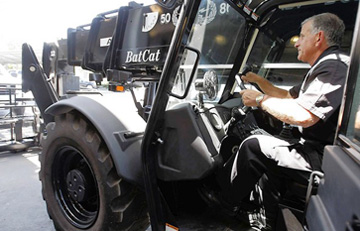You could call it the Los Angeles Police Department's version of a Transformer.

LAPD Bomb Squad officer Ron Capra operates Batcat, the department's huge, remote-control forklift. The machine can lift a vehicle suspected of carrying explosives and move it to safer ground to be defused. (Luis Sinco, Los Angeles Times / May 30, 2010)
The Batcat is a 39,000-pound remote-control vehicle that looks like a forklift truck on steroids with a massive telescopic arm.
It can grab a vehicle like unsuspecting prey and move it from a densely populated area to a safer location.
"We can pick up a large vehicle bomb and move where we want without risk to anyone's life," said LAPD Capt. Horace Frank. "The beauty of this thing is no one needs to get near."
The Batcat - formally called the Bomb Assault Tactical Control Assessment Tool - is part of a new generation of unmanned ground vehicles that operate much like the Air Force's predator drones. It was built on the base of a massive piece of Caterpillar construction equipment known as Telehandler.
The LAPD's bomb squad conceived the idea of installing a remote operating system that turned it into one of the world's largest radio-controlled vehicles.
The Batcat, in its shiny black finish, can be remotely driven up to 6 mph. Its massive arm can extend 50 feet horizontally or vertically and can be equipped with a claw, forklift or bucket. The vehicle, along with a trailer and other accessories, cost the LAPD nearly $1 million.
During a recent test at Camarillo Airport, officials used the Batcat to tackle an ammonium-nitrite and fuel-oil bomb inside a rental van.
Bomb squad technicians used a small robot to disable the control unit inside the van that acts as the bomb's timer and brain. They then maneuvered the Batcat's massive arm to attach an 8-pound C4 explosive countercharge atop the van. A controlled explosion quickly removed the danger of the larger bomb within the truck. The Batcat then grabbed the truck and hauled it away.
"The FBI created the bomb, so we had no idea what we were going to tackle," said Jeffrey Ennis, a bomb squad officer with 20 years of LAPD service who helped design the Batcat.
Remote vehicles like the Batcat, he says, are the future for bomb disposal. Officials said they want to use machines rather than humans to deal with potential explosives.
"You aren't going to see someone out there unless the bomb is wrapped around a person," explains Det. Paul Robi, a bomb squad supervisor and 25-year LAPD veteran. In the modern bomb squad world, he said, "it starts with remote and ends with a remote denotation."
Robi said even the most routine calls can turn deadly. The 5086 decal on the Batcat is a lasting reminder. The 50 stands for 1950, year the squad was founded.
The 86 is a reference to 1986, the year two bomb squad veterans, Arleigh McCree and Ronald Ball, were killed. They were defusing two pipe bombs in the North Hollywood garage of a homicide suspect when an explosion occurred.
"Even a 200-year-old cannonball can be a killer because something stored for a long time can become unstable," Robi said.
With the Batcat and the smaller Andros robots, bomb squad officers can remotely pick up explosives and drive them up to a huge, hollow high-impact steel chamber known as a total containment vessel.
Bombs, Robi said, are a real part of Los Angeles history.
In 1974 the Alphabet Bomber killed three people at Los Angeles International Airport. In 1990, engineer Dean Harvey Hicks parked a truck filled with 2,000 pounds of ammonium nitrate near an Internal Revenue Service office in West Los Angeles that could have leveled two blocks.











